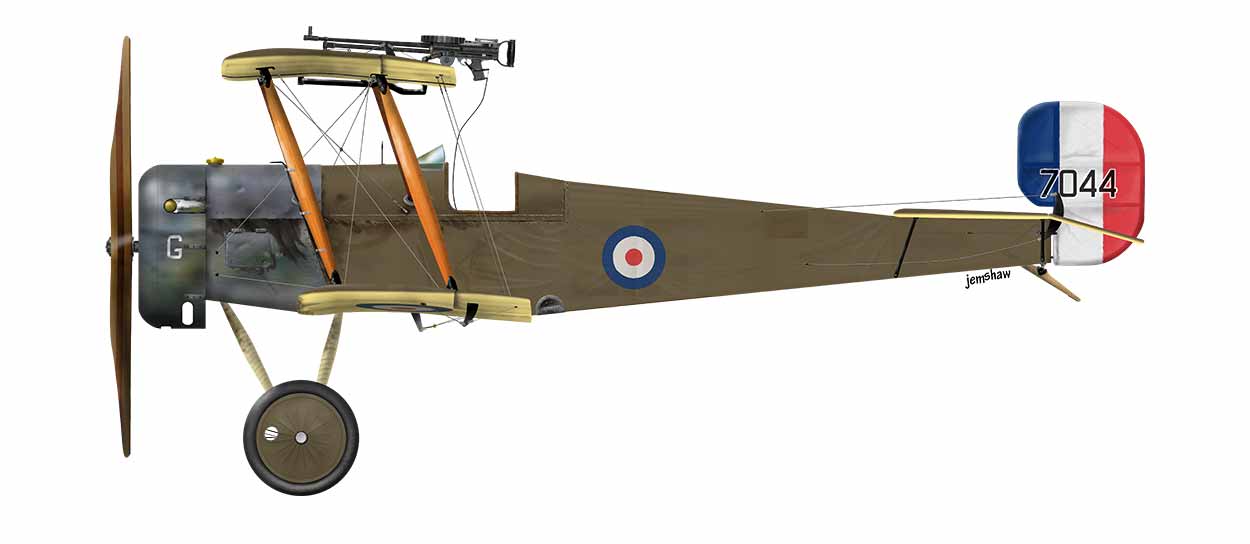| | | The Larks | | | All This Way for a Shilling | | | Yellow Impi | | | Back Burner | | | Other Nonsense | | | About Me |



Bristol Scout (1914)
Colin's First Kite
In The Larks, Colin Hingley's performance flying touch-and-goes in the B.E.2c is superior to Andy Palmer's in that he manages not to crash it. As a result, he's proud to receive the squadron's most battle-worn Scout to call his own. First flying in 1914, the Scout was a remarkably advanced design. In comparison to the Etrich-Rumpler, introduced only two years earlier, it's of an entirely different era. It quickly exceeded 100mph in even a shallow dive and was robust and manoeuvrable. But German technology progressed far more rapidly than British, and by 1916 the Scout was being left rapidly behind. by its opponents.
As Britain had no dependable interruptor gear (the mechanism that allows a machine gun to shoot through the propeller arc), early Scouts had a Lewis gun mounted on the left side of the fuselage, angled out and down to clear the propeller. This set-up meant that the pilot had to yaw out of line with his quarry in order to aim the shot. As a result he'd lose speed as well as having to cope with a constantly changing aiming angle. Intrigued by what this would do to aerial combat, I wrote an account of Colin's first aerial encounter, only to discover that by the time of The Larks, this arrangement had been replaced by a Lewis mounted on the upper wing, aimed to fire above the prop arc. Back to the keyboard...
General |
|
| Country of origin: | Great Britain |
| Crew: | 1 |
| Purpose: | Fighter |
| Powerplant: | 1 × Le Rhône 9C 9-cylinder air-cooled rotary piston engine, 80 hp (60 kW) |
| Armament: | 1 × .303in (7.7mm) Lewis machine gun |
Performance |
|
| Maximum speed: | 151km/h (94mph) |
| Maximum ceiling: | 4,900m (16,000 ft) |
| Range: | 301km (187 miles) |
Dimensions |
|
| Wingspan: | 7.5m (24ft 7in) |
| Length: | 6.3m (20ft 8in) |
| Height: | 2.6m (8ft 6in) |
| Weight: | 358kg (789 lb) |
Figures from Wikipedia
My Picture
Having had the great privilege of clambering over David Bremner's superb rebuild of his grandfather's Scout, I realise I grossly underestimated the degree of oil staining - another item for my to-do list. I strongly recommend David's book, Bristol Scout 1264: Rebuilding Granddad's Aircraft.
Early Bristol Scouts had their single gun mounted obliquely on the side of the fuselage. This proved unsatisfactory in combat (surprise surprise!), so most had the gun moved to the top wing so as to clear the airscrew. My Scout is an early model - in fact if you look closely you can just make out that the fuselage roundel has been painted over the older Union Flag marking that was originally used to identify British aircraft for the early part of the Great War. I decided that the modification to move the gun would probably have been the result of an airfield engineer's ingenuity, so that's what you see in the illustration. It consists of an improvised mounting and a bowden cable that operates a lever attached to the trigger. Replacing the magazine in flight would have been, at the very least, a challenge as it lacks the arc slide that later allowed the gun to be brought within reach of the pilot.
Pages
Copyright © 2016-2024, Jem Shaw

